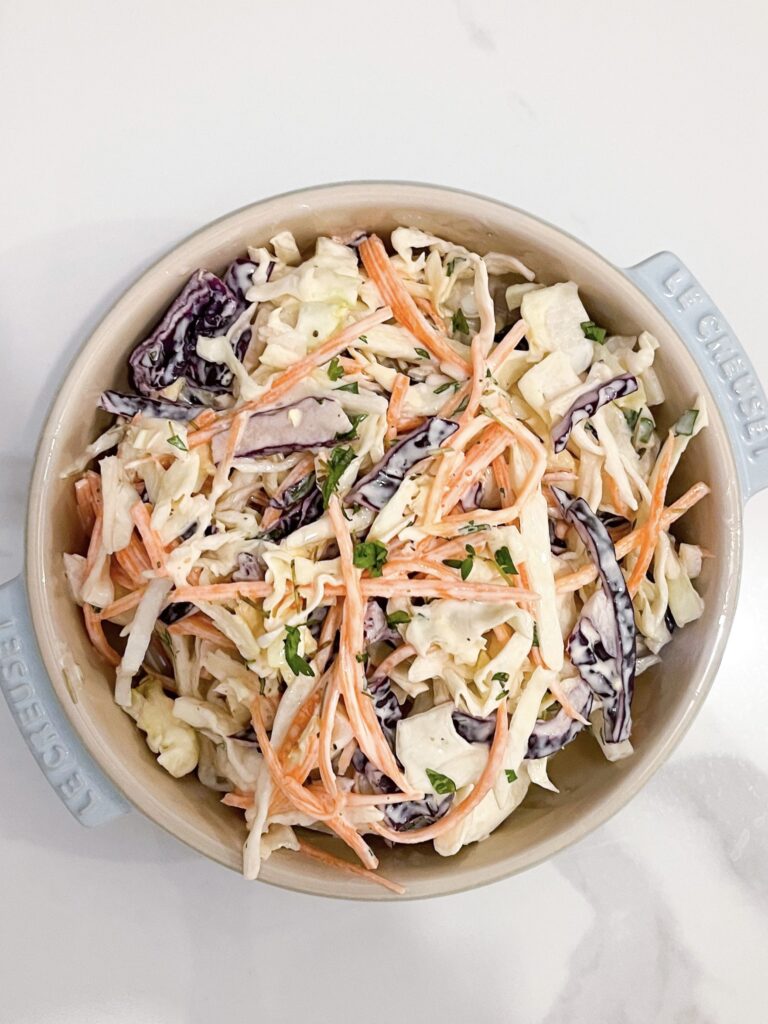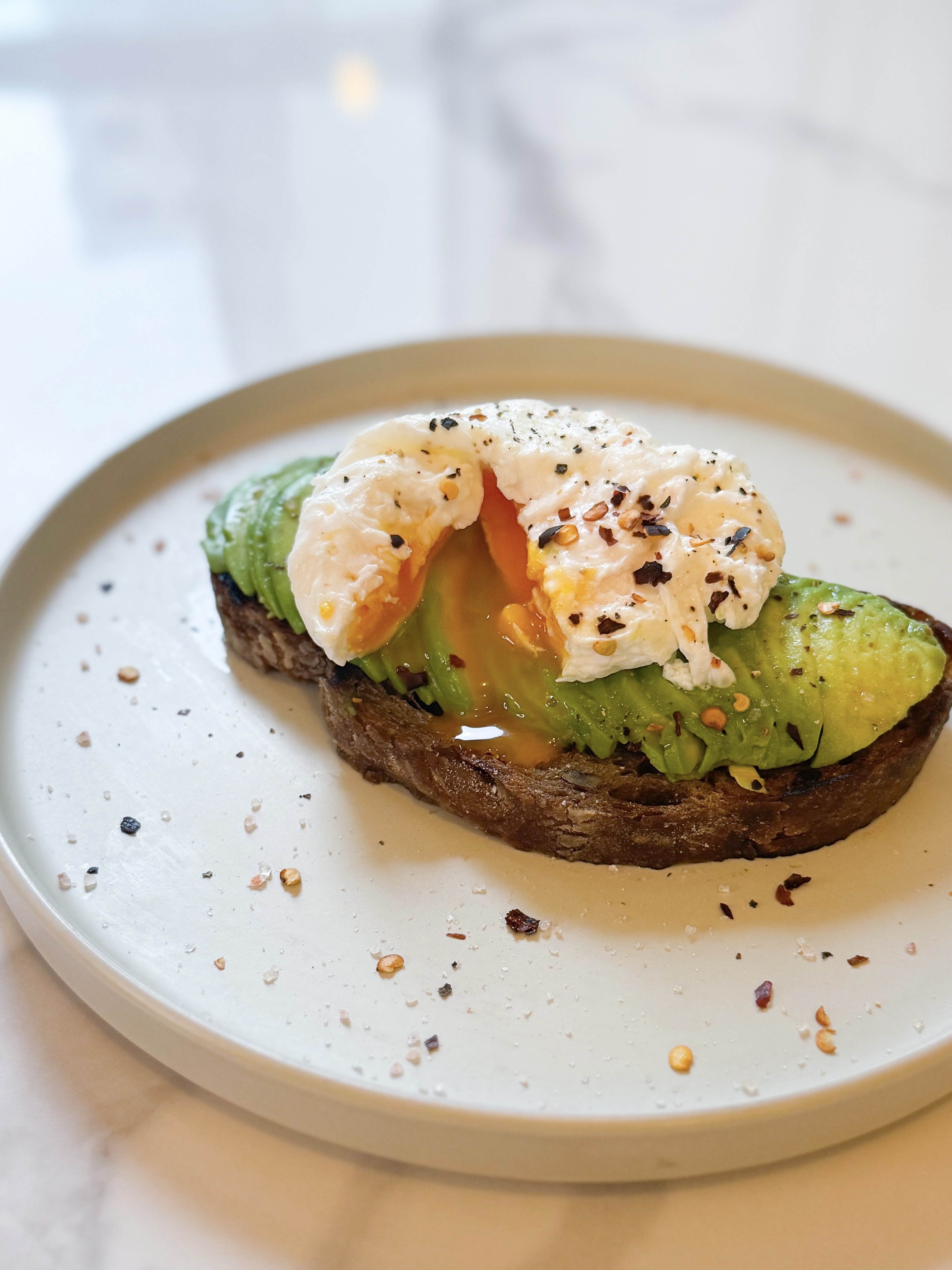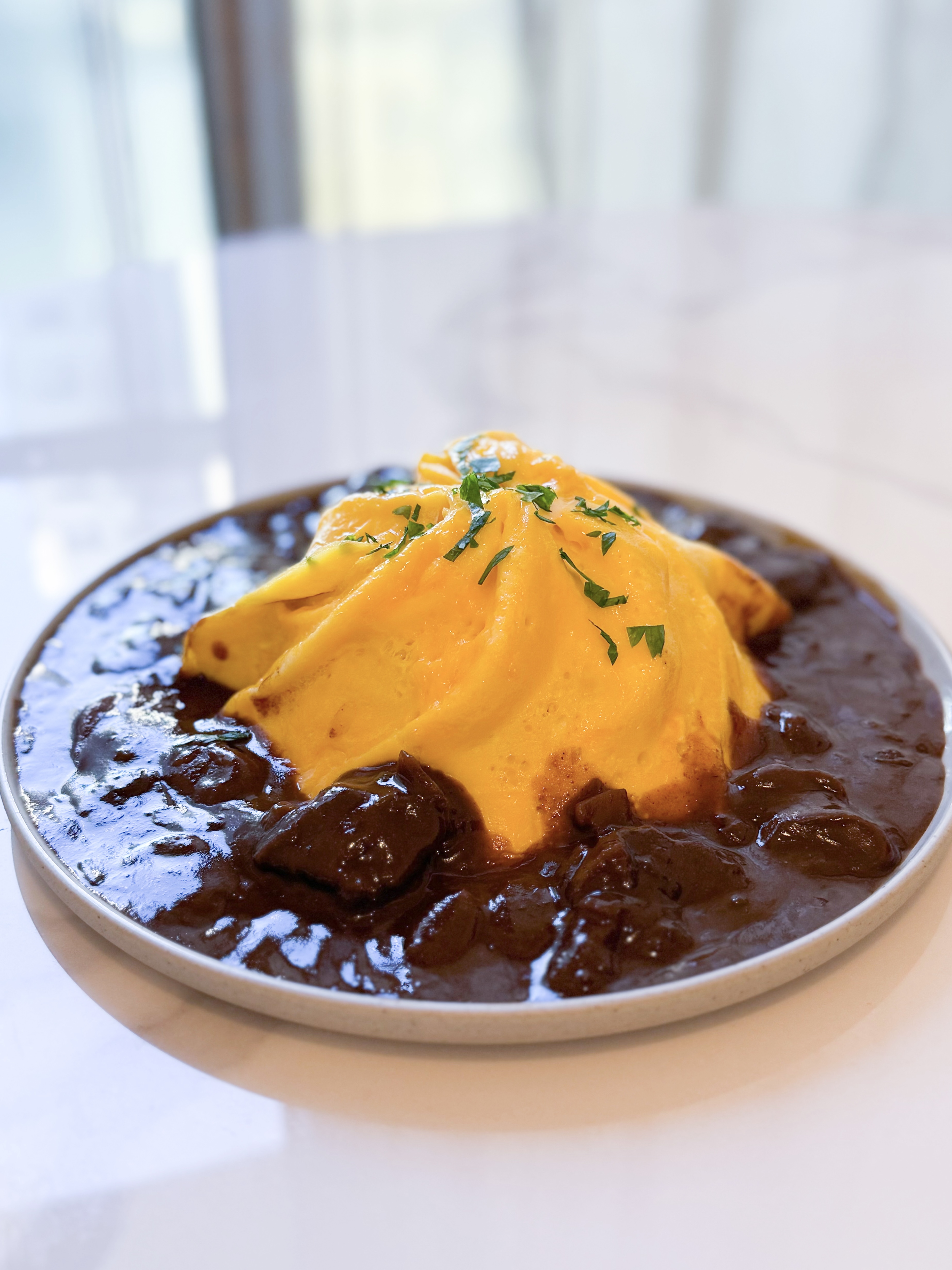What is Coleslaw?
Coleslaw, often simply referred to as “slaw,” is a classic salad dish made from shredded or thinly sliced raw cabbage and sometimes other vegetables. It’s typically dressed with a creamy, tangy, and slightly sweet mayonnaise-based dressing, though there are variations that use vinaigrette or other dressings. Coleslaw can be served as a side dish or condiment and is commonly associated with barbecue, fried chicken, and other comfort foods.
While the base of coleslaw is cabbage, it can be enhanced with various ingredients such as shredded carrots, onions, bell peppers, and even fruits like apples or pineapple for added flavor and texture. The dressing usually contains mayonnaise, vinegar, sugar, and seasonings like celery seed or mustard. Some variations use a yogurt-based or vinaigrette dressing for a lighter and healthier option.
Coleslaw is a versatile dish, and its flavor can range from sweet and creamy to tangy and slightly spicy, depending on the recipe. It’s a popular side dish at picnics, cookouts, and family gatherings and can be served alongside sandwiches, burgers, hot dogs, or as a topping for dishes like pulled pork sandwiches.
What are the Ingredients to Make Coleslaw?
To make a classic coleslaw, you will need the following ingredients:
For the Coleslaw:
- 1 small head of green or white cabbage (about 2 pounds)
- 2 large carrots
- Optional: other vegetables like red cabbage, bell peppers, or onions for added color and flavor (use about 1 cup in total)
For the Dressing:
- 1 cup mayonnaise
- 2 tablespoons white sugar
- 2 tablespoons apple cider vinegar
- 1 teaspoon Dijon mustard (optional, for added flavor)
- 1/2 teaspoon celery seed (for a touch of earthy flavor)
- Salt and black pepper to taste
How to Make A Healthy Homemade Coleslaw?
Creating a healthier coleslaw is relatively simple. You can make some ingredient substitutions and choose lighter dressings to reduce the overall calorie and fat content. Here’s how to make a healthier dressing:
For the Healthier Dressing:
- 1/2 cup plain Greek yogurt (replaces some or all of the mayonnaise for a lighter option)
- 2 tablespoons white sugar (you can reduce the sugar for a less sweet coleslaw)
- 2 tablespoons apple cider vinegar
- 1 teaspoon Dijon mustard (optional, for added flavor)
- 1/2 teaspoon celery seed (for a touch of earthy flavor)
- Salt and black pepper to taste
By substituting some or all of the mayonnaise with Greek yogurt, you reduce the fat content while adding protein and creaminess. Reducing the sugar in the dressing also makes the coleslaw less sweet and lowers the calorie content. This version of coleslaw retains the classic flavors while offering a healthier twist.
How to Make Coleslaw?
Here are the instructions to make classic coleslaw:
Instructions:
- Prepare the Vegetables:
- Shred the cabbage finely using a knife or a food processor. You can also buy pre-shredded cabbage for convenience.
- Peel and grate the carrots.
- Combine the Vegetables:
- In a large mixing bowl, combine the shredded cabbage and grated carrots. If you’re using other vegetables, add them at this stage.
- Prepare the Dressing:
- In a separate bowl, whisk together the mayonnaise, sugar, apple cider vinegar, Dijon mustard (if using), celery seed, salt, and black pepper. Taste the dressing and adjust the sugar or vinegar to your preference.
- Toss and Chill:
- Pour the dressing over the vegetables and toss everything together until the cabbage and carrots are well coated with the dressing.
- Cover the bowl and refrigerate the coleslaw for at least an hour before serving to allow the flavors to meld.
- Serve:
- When you’re ready to serve, give the coleslaw a final toss to ensure it’s well mixed. Serve it as a side dish or a topping for sandwiches, burgers, or barbecue dishes.
These instructions will help you make a classic, homemade coleslaw that’s perfect for picnics, barbecues, and a variety of dishes. Feel free to adjust the ingredients and seasonings to suit your taste.
What is the Best Way to Serve Coleslaw?
Coleslaw can be served in various ways, depending on your preference and the occasion. Here are some popular ways to serve coleslaw:
- Side Dish: Coleslaw is often served as a classic side dish, accompanying dishes like barbecue, fried chicken, or grilled meats. It complements rich and savory flavors with its crisp and creamy texture.
- Burger Topping: Coleslaw makes an excellent topping for burgers and sandwiches. Placed inside a sandwich, it adds a delightful crunch and a touch of creaminess.
- Hot Dog Topping: Coleslaw can be used as a topping for hot dogs, adding a refreshing contrast to the savory and smoky flavors of the sausage.
- Pulled Pork Sandwich: Coleslaw is a common topping for pulled pork sandwiches. The combination of tender, flavorful pulled pork and the crunch of coleslaw creates a perfect balance.
- Wrap or Taco Filling: Use coleslaw as a filling for wraps or tacos. It adds a refreshing and textural component to the dish.
- Salad: Coleslaw can be a stand-alone salad, especially when you add ingredients like shredded chicken, bacon, or nuts. A lighter dressing, such as vinaigrette, can be used for this purpose.
- Potluck or Picnic Dish: Coleslaw is a popular potluck or picnic dish. It’s easy to transport, doesn’t require refrigeration for short periods, and pairs well with other barbecue and picnic foods.
- Light and Healthy Meal: If you’re looking for a light and healthy meal option, serve coleslaw as a main dish by adding grilled chicken, fish, or tofu.
- Variations: There are numerous variations of coleslaw, such as broccoli slaw (using broccoli stems), Asian slaw (with a soy-based dressing), or vinegar-based slaw (with less mayo). Experiment with these variations to find the best way to serve coleslaw that suits your taste and the meal you’re planning.
Regardless of how you choose to serve coleslaw, it’s a versatile and refreshing side dish that can be tailored to complement various meals and occasions.
How To and How Long Can I Store Coleslaw?
Storing coleslaw is relatively straightforward, but it’s important to follow some guidelines to maintain its freshness and safety. Here’s how to store coleslaw and how long you can keep it:
Refrigeration (Short-Term Storage): Coleslaw can be stored in the refrigerator for short-term use, typically up to 3-5 days. Here’s what you should do:
- Use an Airtight Container: Place the coleslaw in an airtight container. This will help keep the air out and prevent the coleslaw from drying out or absorbing other odors in the fridge.
- Keep It Cold: Store the container in the coldest part of your refrigerator, usually around 32-40°F (0-4°C).
- Avoid Dressing Separation: If the coleslaw has dressing, you may notice some separation over time. Simply give it a gentle toss before serving to recombine the dressing with the vegetables.
Long-Term Storage (Freezing – Not Recommended): Freezing coleslaw is generally not recommended because it can alter the texture and quality of the dish. Vegetables like cabbage and carrots tend to become watery and lose their crispness when frozen. If you do decide to freeze it, follow these steps:
- Portion Control: Divide the coleslaw into individual portions or the amount you plan to use at once.
- Seal in Freezer Bags: Place each portion in a freezer-safe, airtight bag. Squeeze out as much air as possible before sealing.
- Label and Date: Label the bags with the date of preparation for reference.
- Store in the Freezer: Place the bags in the freezer. Be aware that when you thaw the frozen coleslaw, the texture may be less desirable.
While refrigeration is the preferred method for storing coleslaw, it’s best to consume it within a few days to enjoy it at its freshest. If you’re concerned about having leftover coleslaw that won’t be consumed within a short time, you can consider making smaller batches or using the coleslaw for recipes like sandwiches or wraps to avoid potential waste.

Healthy Homemade Coleslaw Recipe
Description
Creating a healthier coleslaw is relatively simple. You can make some ingredient substitutions and choose lighter dressings to reduce the overall calorie and fat content. Here’s how to make a healthier coleslaw:
Ingredients
For the Coleslaw:
For the Healthier Dressing:
Instructions
- Prepare the Vegetables:
Shred the cabbage finely using a knife or a food processor. You can also buy pre-shredded cabbage for convenience.
Peel and grate the carrots. - Combine the Vegetables:
In a large mixing bowl, combine the shredded cabbage and grated carrots. If you’re using other vegetables, add them at this stage. - Prepare the Healthier Dressing:
In a separate bowl, mix the Greek yogurt, sugar, apple cider vinegar, Dijon mustard (if using), celery seed, salt, and black pepper. Taste the dressing and adjust the sugar or vinegar to your preference. - Toss and Chill:
Pour the healthier dressing over the vegetables and toss everything together until the cabbage and carrots are well coated with the dressing.
Cover the bowl and refrigerate the coleslaw for at least an hour before serving to allow the flavors to meld. - Serve:
When you’re ready to serve, give the coleslaw a final toss to ensure it’s well mixed. Serve it as a side dish or a topping for sandwiches, burgers, or barbecue dishes.
Notes
- By substituting some or all of the mayonnaise with Greek yogurt, you reduce the fat content while adding protein and creaminess. Reducing the sugar in the dressing also makes the coleslaw less sweet and lowers the calorie content. This version of coleslaw retains the classic flavors while offering a healthier twist.






